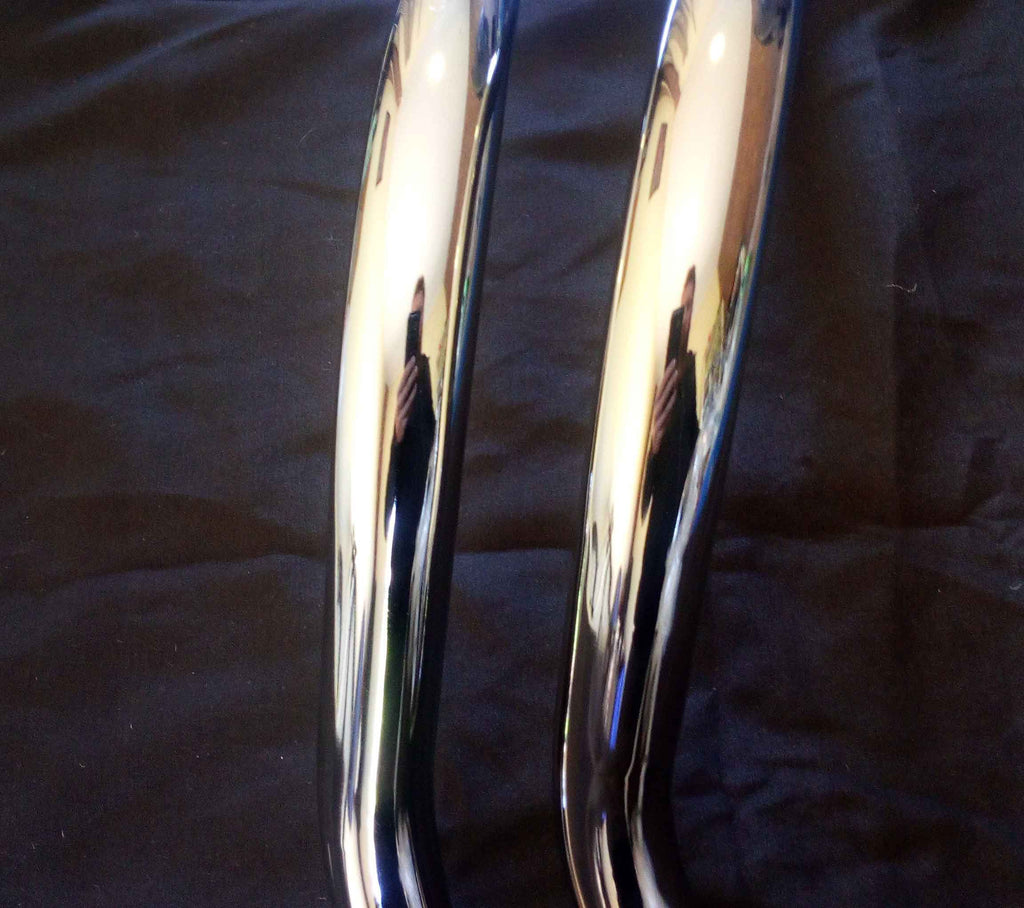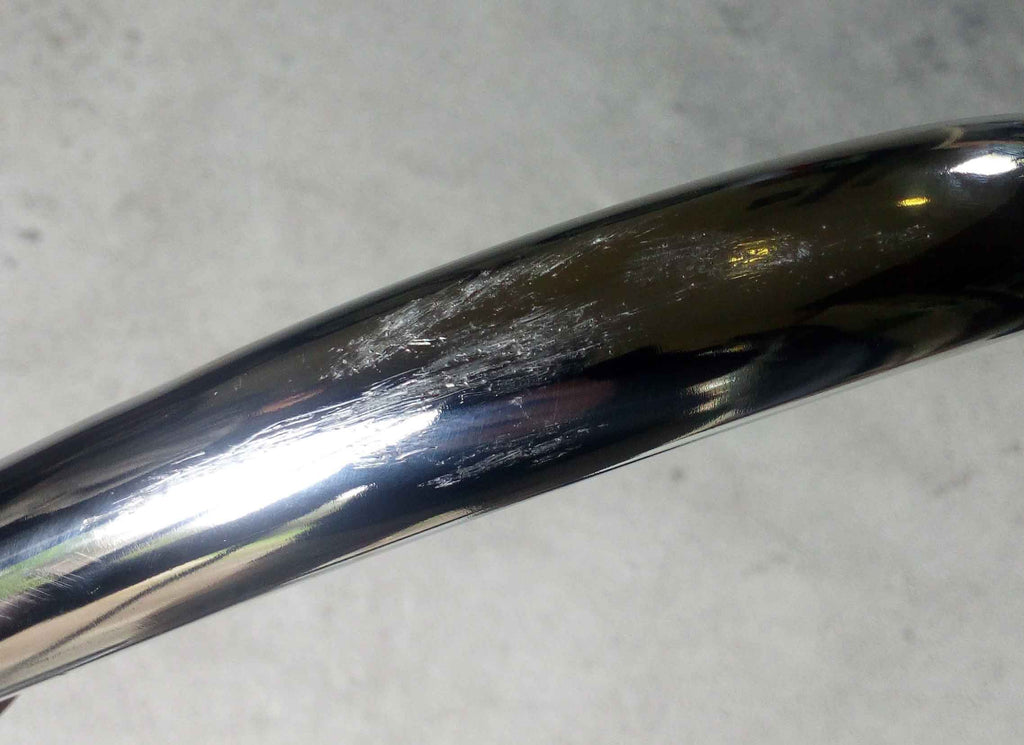
Stainless Steel vs Chrome Handlebars: Which is Better?
Stainless Steel or Chrome Plated Handlebars, Which is better? Will my handlebars rust? Which is stronger?
Like many riders, you may be finding yourself asking these same questions and wondering which route to go for your next set of Handlebars.
Some manufacturers, including Harley-Davidson, now also use Stainless bars on their stock motorcycles. Let’s find out why.
What’s the difference?
Stainless Steel is an iron-based metal alloy, with added elements including chromium, nickel, silicon and carbon. These elements are mixed into the base material itself, and are present throughout the entire structure of the Handlebar.
The surface of the Stainless Steel is then finely polished to a mirror finish. Because the Stainless properties are evident throughout the entire bar, any damage or scratches can simply be re-polished to expose the fresh new material underneath.
Alternatively, Chrome Plated Handlebars have a shiny chromium plating which is present only in a thin outer layer roughly 2 microns (two thousands of a millimetre!) in thickness.
This thin layer is susceptible to peeling, flaking or delaminating from the base material.
If the Chrome Plating is scratched or chipped through to the base metal, it will rust. This will cause streaking, pitting and further delamination of the Chrome layer.
Which looks better? How long will they last?
Fresh out of the box, you would be hard-pressed to tell the difference between Chrome Plated and mirror-polished Stainless Steel Handlebars.
If you have a really keen eye, you might be able to notice that Chrome has a hint of blue undertones, while the Stainless has a slight yellow undertone.
See below for a side-by-side comparison. Can you tell which is which?

Chrome Plated Handlebars (left) next to mirror-polished Stainless Steel (right).
While Chrome Plated bars may be the cheaper option, it is important to consider how well your handlebars will keep their shiny aesthetics and how robust they will be after a longer period of time.
I’m sure we’ve all seen our share of bikes (even the high-end models!) that show a startling amount of pitting and rust on their Chrome parts after a few years of regular use.
Handlebars, indicators, fork clamps, fenders and exhaust pipes are typically parts that show a fair degree of pitting after just a few years use. This is made far worse if the owner isn’t able to keep the bike in a fully enclosed storage area.
The fact is, pitting is basically going to be inevitable on any Chrome Handlebars. After a certain amount of riding, an accumulation of stone chips, stuck-on bugs and road grime will expose the bare steel and allow rust pitting to settle in.
Here’s an example of a high quality Chrome Handlebar taken from a well-looked after motorcycle. Even though this bike has been garaged and maintained regularly, we can’t stop damage which occurs whilst riding. These stone chips are where the rust begins to take hold.

Beginnings of rust pitting on a Chrome Plated Handlebar.
When left to worsen over a few years, the Handlebars will eventually come up looking something like this:

Advanced rust pitting on a Chrome Handlebar.
This is the major benefit of Stainless steel handlebars compared to Chrome bars; Stainless will never rust or pit.
And even though they do have a slightly lower resistance to scratching, this will never result in rust or further damage if left untreated, and can always be buffed back to that original shiny lustre.
This is especially critical if you must keep your bike outside or in a non-enclosed carport; where pitting can settle in amazingly fast, especially on low quality Chromed items.
How to fix scratches & repair damage
Stainless Handlebars can be re-polished to a mirror finish in the event of scratching or damaging them.
Since the Stainless properties are evident throughout the entire material, it’s even possible to remove deep scratches from your Handlebars.
· Minor scratches and marks can be removed using metal/chrome polish and a buffing wheel.
· For deep scoring, sand down the scratch or deep score until it is smooth, and re-polish using fine grit sandpaper followed by polishing compound and a buffing wheel.

“It’ll buff out!” Believe it or not, a scratch this serious can still be removed from a Stainless Steel Handlebar.
We ran these Handlebars across concrete causing scratches, dull patches and indentation. With sandpaper, polishing compound, polishing wheel and some elbow grease this damage can be completely removed and the surface returned to its previous mirror finish.

Stainless Handlebar after scratch removal.
Strength & Safety
First of all, it should be noted that you aren’t going to be able to bend either type of handlebars with your hands or arms. This means it is impossible to bend your Handlebars during normal riding, and the only way any good quality handlebars will be bent is during a crash.
That being said, if the only way you’re going to bend your handlebars is by crashing, then you want your handlebars to help the situation if a crash occurs.
In a nutshell, stainless steel has a slightly lower yield strength compared to plain carbon steel, but a higher breaking strength.
It is between these two points; bending and breaking, that energy is absorbed into the material and away from the crash. See the graph below which illustrates this phenomenon:

Energy Absorption of 304 Stainless vs 1020 Carbon Steel.
This is very beneficial in the event of a crash, as any energy absorbed into the Handlebars from impact will work to reduce the speed of the bike and its rider.
If your Handlebars absorbed no energy when dropped in a crash, they would bounce and make the bike airborne, extending the crash, or have your front end bounce and whip around uncontrollably.
Think of a crash helmet, which has soft inner padding to deform and absorb energy. If they were made only with a hard outer shell, the energy would be deflected, causing your head to bounce and return for a second impact.
Stainless in Other Areas
Mirror Polished Stainless Steel is a commonly used material in industries where cleanliness and corrosion resistance is of extremely high importance.

Polished Stainless Steel surgical equipment.
Industries such as food manufacturing and surgical equipment use similar types of Mirror Polished Stainless to meet the exacting requirements for which the materials are needed.
To Summarise:
Stainless Handlebars
· Far superior rust, stain and pitting resistance
· Lower maintenance
· Can be re-polished to mirror finish
· Better impact absorption
· Stronger breaking point
Chrome Plated Handlebars
· Cheaper material cost
· Can be prone to pitting or flaking
· Cannot repair major scratches
· Exposed steel will rust and delaminate the Chrome layer
We hope you enjoyed this article, and that we answered any questions you may have had about the properties of Stainless Handlebars. If you have any thoughts or comments on this article, please leave a comment below!